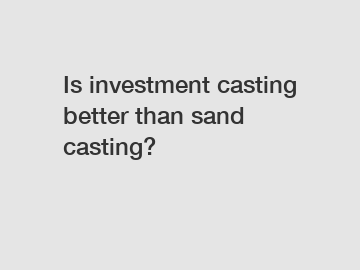Is investment casting better than sand casting?
Is investment casting better than sand casting? The answer is not as simple as a straightforward "yes" or "no." Both investment casting and sand casting have their own strengths and weaknesses, and the choice between the two methods would depend on various factors such as the complexity of the part, the required precision, and the material being used.
Investment casting, also known as lost-wax casting, is a process that involves creating a wax model of the part to be cast and then covering it with a ceramic shell. The wax is then melted away, leaving a cavity in the ceramic shell which is filled with molten metal to form the final part. This process allows for very precise and intricate parts to be created, with excellent surface finish and minimal machining required.
On the other hand, sand casting is a more traditional process that involves creating a mold by packing sand around a pattern of the part to be cast. Molten metal is then poured into the mold, solidifying to form the final part. Sand casting is a simpler and more cost-effective process compared to investment casting, making it ideal for large and less complex parts.

While investment casting offers superior precision and surface finish, it is also more expensive and time-consuming compared to sand casting. The initial tooling costs for investment casting are higher, and the process requires more steps and labor to complete. In contrast, sand casting is faster and more economical for producing larger quantities of simple parts.
However, despite the higher cost and longer lead time, investment casting is often preferred for parts that require high accuracy, tight tolerances, and intricate details. It is commonly used in industries such as aerospace, automotive, and medical, where quality and precision are of utmost importance. Sand casting, on the other hand, is suitable for larger parts where cost and speed are more critical factors.
In conclusion, the choice between investment casting and sand casting ultimately depends on the specific requirements of the part being produced. While investment casting offers superior precision and surface finish, it comes at a higher cost and longer lead time. Sand casting, on the other hand, is more cost-effective and quicker for producing large quantities of simple parts. Both casting methods have their own advantages and limitations, and it is important to weigh these factors carefully before making a decision.
Want more information on Lost wax casting for film industry props, wire rope fittings oem investment casting, Lost wax casting for film industry props? Feel free to contact us.

Comments
0